 |
||
 |
||
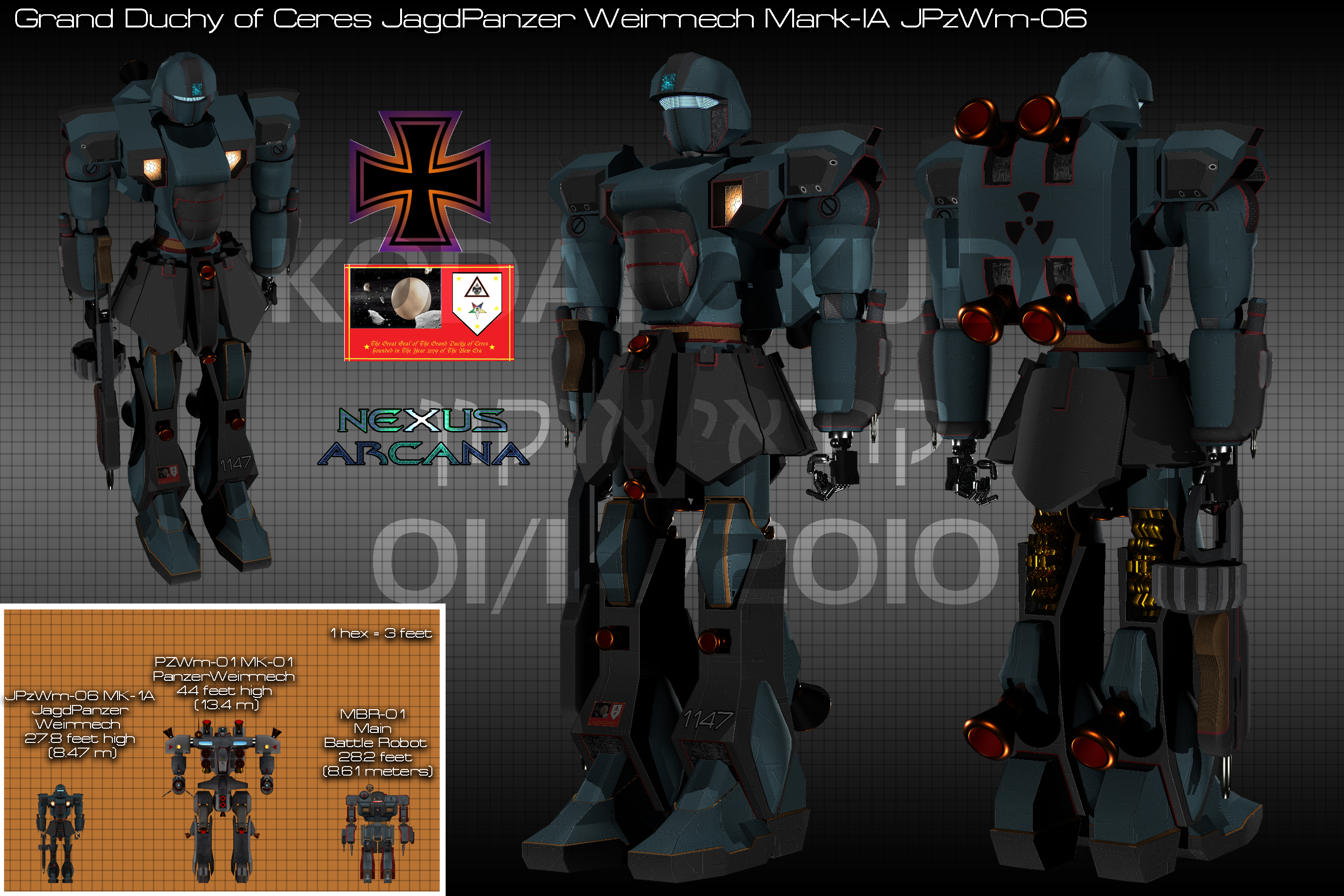
GOVERNMENT: Grand Duchy of Ceres (originally developed by the Ceres Regency)
TYPE: Main Battle Robot
MODEL: JagdPanzer WeirMech JPzWm-06
SUBTYPES
Mark-IA Basic Unit
Mark-IG General Infantry
Mark-IB Bazooka Model
Mark-IN NCO Model
Mark-IO Officer Model
DATE INTRODUCED: 2182 AD
LENGTH (Depth): 10.8 ft. (3.3 meters)
WIDTH: 13.7 ft. (4.16 meters)
HEIGHT: 27.8 ft. (8.47 meters)
MATERIAL: Crystal Composite
POWER PLANT: 1x Altair Energy AEFR-02 (Level II)
OUTPUT: 2 megawatts (16,000 kilowatts required)
ARMOR TYPE: Crystal Composite
ARMOR THICKNESS: 2.5 inches
DISPLACEMENT: 10 tons
CREW: 1 Pilot
PROPULSION
PRIMARY (GROUND):
1x Mezzersmit WE-32 walker engine
SPEED: 40 mph
PRIMARY (FLIGHT):
Yunkers YFT-01 Fusion Thruster
SPEED: 1520 mph each (9210 total)
(Delta-V: 9210 mph Z-axis/Forward; 6080 mph y-axis Top; 3040 mph Downward & Reverse.)
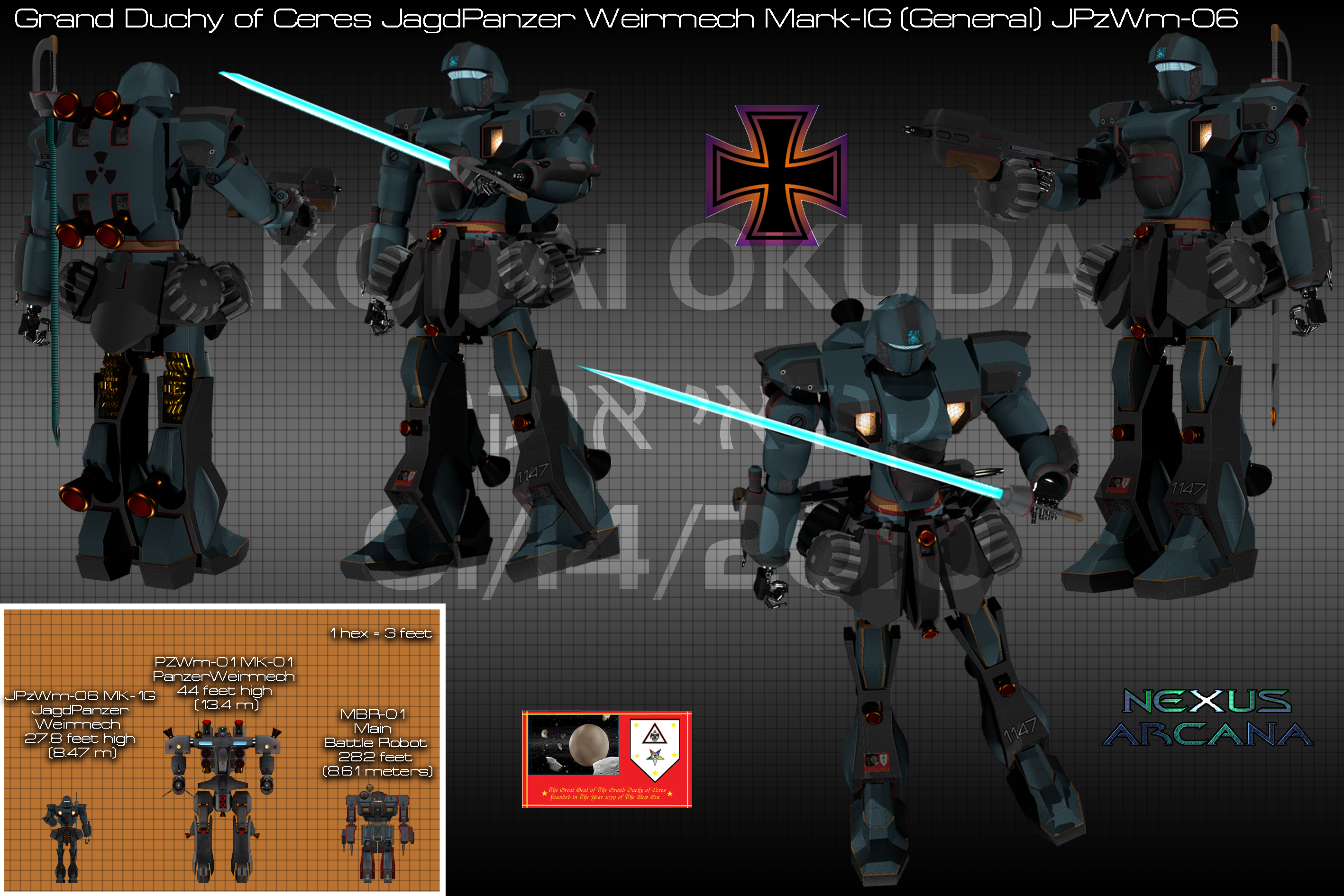
WEAPONS:
(ALL MODELS):
2x Mawzer Mz-AC-25 25mm autocannon; Effective Range: 1800-feet; Payload: 200-round drum; ROF: bursts of 5, 10, or 20 rounds per 2-seconds for a maximum of 600-rounds per minute.
(MK-1G, MK-1N, MK-1O):
1x Mawzer Mz-RCGP-35 35mm rail cannon 1-ton gun pod; Effective Range: 1141 yards; Payload: 1000-round drum (up to five drums carried for total of 5000-rounds); ROF: select-fire, can fire semi-auto (1-shot per pull of the trigger), or in bursts of 5, 10, 20, or 50-rounds per pull of the trigger for a maximum of 1500-rounds per minute.
(MK-1G, MK-1B, MK-1N):
1x Gever G-PS-240 240-megawatt 2.4-ton Plasma Sword; Effective Range: 20-feet; Payload: unlimited; ROF: as per the pilot's dexterity, usually around 4 to 6 swings per 2-seconds.
(MK-1B):
1x Mawzer Mz-Bz-450 450mm Bazooka; Missile Type: Ceres Type-80 450mm Rocket Propelled Plasma Grenade; Effective Range: 1.05 miles; Payload: 8 RPPGs per box magazine (up to five magazines carried for a total of 40-RPPGs); ROF: 1 RPPG per 2-seconds for a total of 30-grenades per minute.
(MK-1O):
1x Watzler WBC-04 2-ton Beam Ax; Effective Range: 20-feet; Payload: unlimited; ROF: as per the pilot's dexterity, usually around 4 to 6 swings per 2-seconds.
ELECTRONICS:
1x Microwave Radio Communications array with a 6000-mile range.
1x Laser communications system with 5000 mile range
1x Passive EMs array with a range of 10,000 miles.
1x RADAR array with a range of 5,000 miles.
1x Multispectral Video/Optical array with a range of 1000 miles.
1x LADAR arrawy with a range of 10,000 miles.
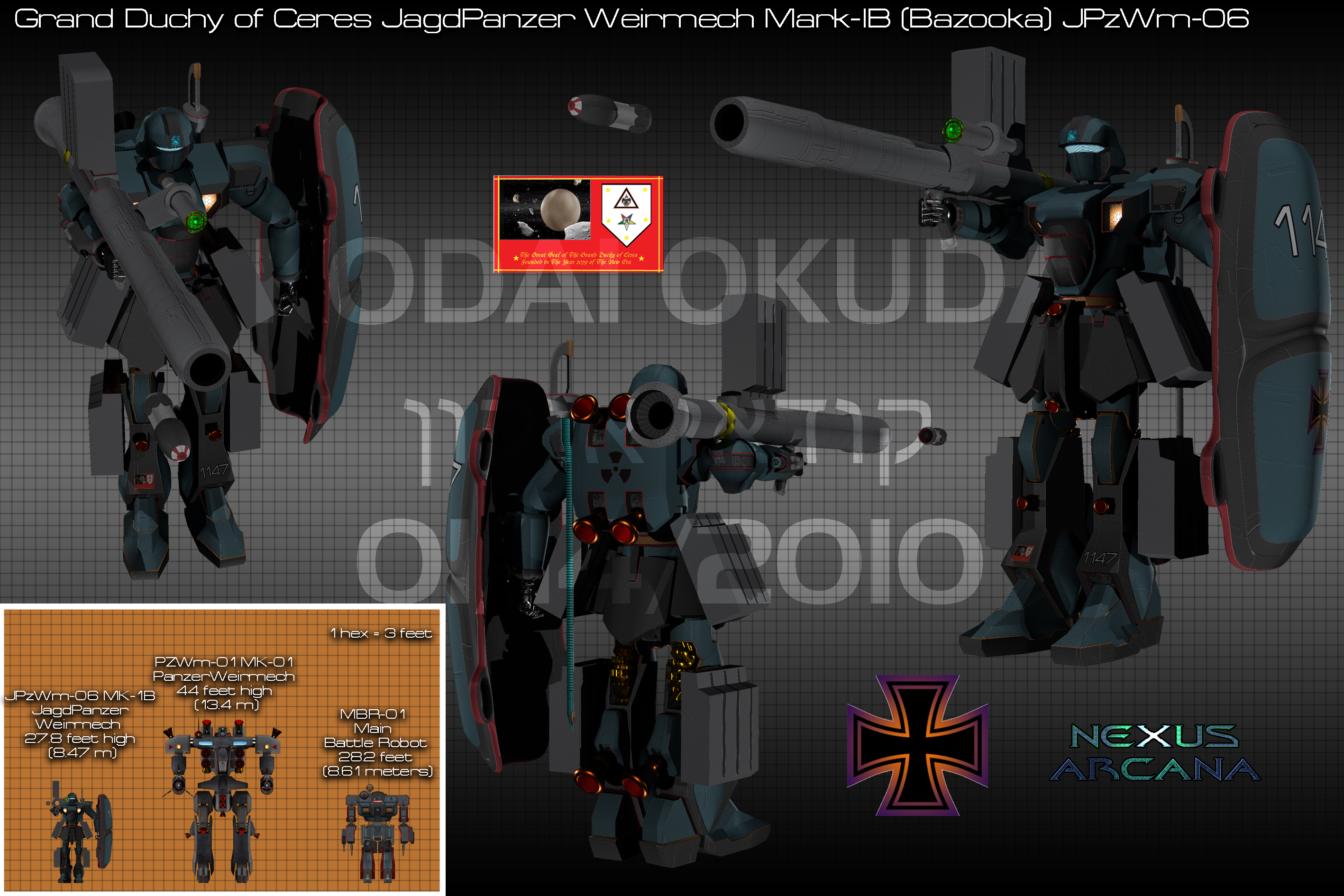 1x Neural Link System; Effect: provides a direct link between the pilot’s synaptic brain impulses, via a telemental helmet, and the BattleKnight’s computer control systems providing enhanced control and maneuverability for the pilot of the machine.
1x Neural Link System; Effect: provides a direct link between the pilot’s synaptic brain impulses, via a telemental helmet, and the BattleKnight’s computer control systems providing enhanced control and maneuverability for the pilot of the machine.
DEFENSE SYSTEMS:
2x Mawzer Mz-CL-5100 Chaffe launchers; Effective Range: 100 yards with a 200-foot area of effect; Payload: 100 bomblets each; ROF: 1-10 bomblets per 2-seconds (60 bomblets total per minute); Effect: 60% chance of detonating incoming missiles.
(MK-1B, MK-1N, MK-1O)
1x Watzler WHCS-ER3K 1.6 ton Engergy Resistant heavy combat shield; Effect: ARMOR THICKNESS: 5 inches; DIMENSIONS: 18 feet long, 8 feet wide, 2 feet thick; ENERGY RESISTANCE: Damage of energy weapons are reduced as follows: Laser/PHELAC: 50%, EMPAC, PAC: 10%, Particle Beam Cannon: 5%, BLASTERS/DISRUPTORS: 15%
Description/Overview:
The possible failure of the Corpse-Corps caused Charles Dalltan to pursue an emergency alternative program for a small, battle suit sized, multipurpose battlerobot of no more than 15 tons, but larger than 8 tons displacement. The Mawzer company of Pallas took up the task of fulfilling this mandate as soon as the Grand Duke made his demands known. The JPzWM-06 JagdPanzer WeirMech was born from this requirement.
The JagdPanzer was an NLS enhanced, ten ton light battlerobot with few integral weapons, and a variety of armaments carried outside the vehicle. This arrangement allowed for a variety of weapon and equipment combinations. However, five main types were classified for general use. All five “MARKs” were the exact same battlerobot only with different hand held weapons and defense systems. This allowed for an inexpensive combat unit that was both compact and on par with its contemporaries of the post 1st Interplanetary War era.
The JPzWM-06 used one Mezzersmit WE-32 thirty-two megawatt walker engine as its primary land-propulsion unit. This walker drive gave the JagdPanzer a top speed of 40 mph, which was considerable for a machine of its time. For space borne operations and flight within an atmostphere, six Yunkers YFT-01 fusion thrusters were mounted on the battlerobot. This made the JagdPanzer one of the first human built mecha to not use the tried and true thermo-nuclear rocket engines common on nearly all battlerobots built prior to the JPzWM-06. These six engines were compact and used variable nozzles and forward facing reverse-capable intakes that gave the JagdPanzer a delta-V of 9120 miles per hour in space. Due to its poor aerodynamics, the JPzWM-06 had a top speed of only 700 mph in an Earth-like atmosphere due to friction on its surfaces. This made the JagdPanzer a poor choice for planetary assaults due to the need of a dropship to deploy and retrieve the machines from an Earth-like planet.
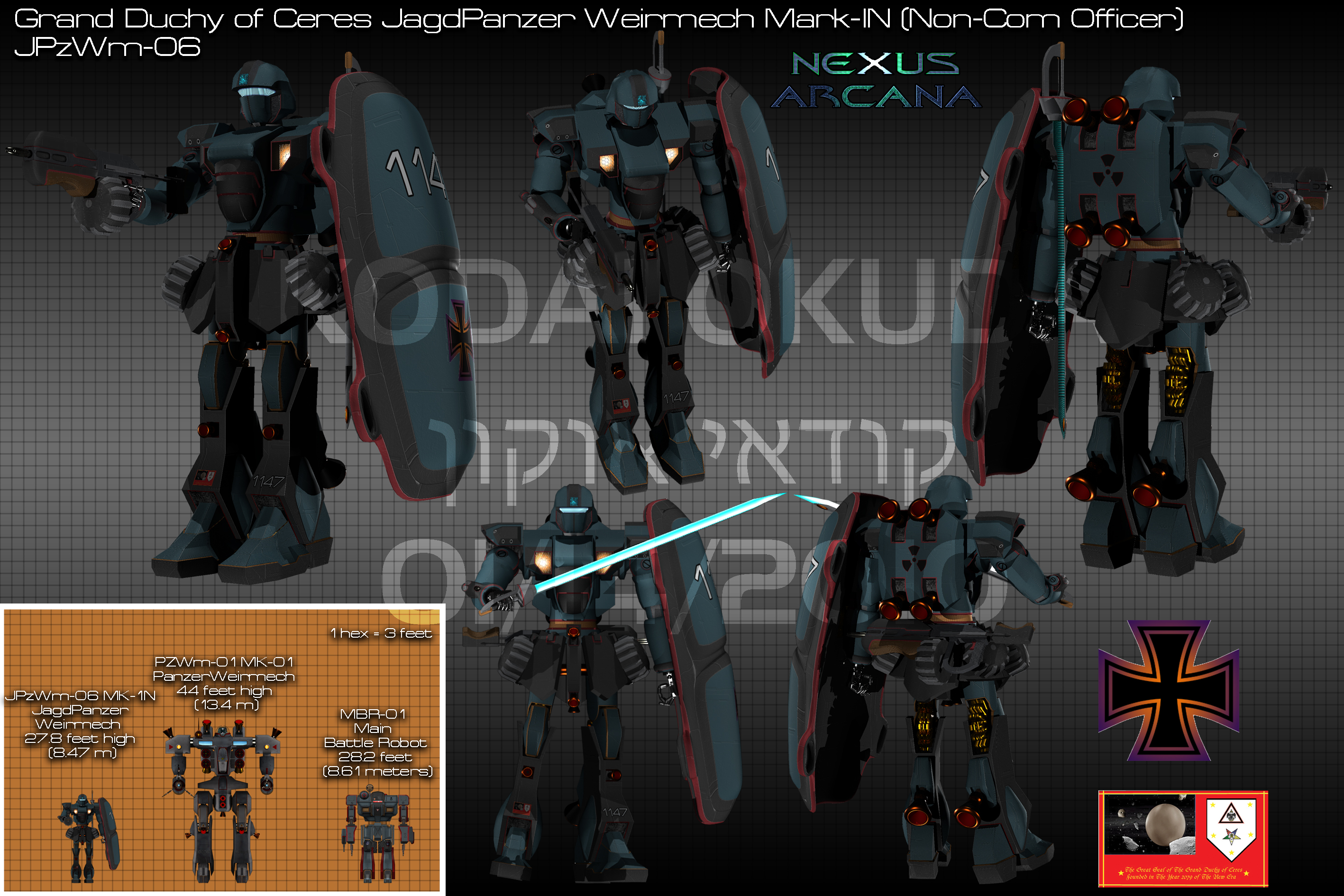 The Grand Ducky’s JagdPanzer didn’t require much in the way of electrical power. A small Ceres Energy CEFR-80 eighty-megawatt fusion reactor was all that it required to power its systems.
The Grand Ducky’s JagdPanzer didn’t require much in the way of electrical power. A small Ceres Energy CEFR-80 eighty-megawatt fusion reactor was all that it required to power its systems.
Integral weapons of the JagdPanzer consisted on only a pair of Mawzer Mz-AC-25 twenty-five millimeter autocannons, one mounted on each forearm of the machine. These autocannons had detachable drum magazines for easy reloading and up to six extra drums could be carried by the mecha on the magnetic hardpoints of the side plates of the machine’s hip armor. JPzWM-06 battle robots using only these weapons were classified as MARK-IA units, which designated a basic configuration.
A variety of outside armaments could be carried by the JagdPanzer, but five main configurations were used to designate which types of weapons were carried.
(MARK-1G GENERAL INFANTRY CONFIGURATION)
The first of these was the MARK-IG, general infantry, configuration that most of the JagdPanzers used. This configuration initially consisted of one Mawzer Mz-RCGP-35 thirty-five millimeter rail cannon gunpod with four extra drum clips (two on each hip armor side plate), and one Gever G-PS-240 two-hundred forty megawatt plasma sword attached to the rear skirt armor under the engine pack. During the Ceres Conflict, the Grand Duchy later upgraded this configuration to include the combat shield and/or the Heavy Bazooka, thus eliminating the MARK-IB, and creating the MARK-IH (Heavy Infantry Configuration). The “H” version was used by special operations groups, base defense units, and recon assault units.
(MARK-1B BAZOOKA CONFIGURATION)
The second main configuration used by mechanized infantry units was the MARK-IB. Normally there was one MK-IB for every four MK-IG JagdPanzers within a platoon. The MK-IB used one Mawzer Mz-Bz-450 four-hundred and fifty millimeter bazooka gunpod as its primary weapon. This devastating gunpod fired a rocket propelled plasma grenade that was capable of defeating the torso armor of nearly any battlerobot of the 1st Interplanetary War era using its HEAP rounds. Other grenade warheads were also available for use with the Mz-Bz-450 (Incendiary, Fragmentation, Explosive) for anti-personnel, and anti-vehicle use. However, the main anti-mecha round was the HEAP. The MK-IB carried four extra box clips for the bazooka (stored on the machine’s hip and leg armor plates) giving it a total of forty RPPGs. In addition to its bazooka, the MK-IB also carried the plasma sword on its rear armored skirt plate like the MK-IG. However, unlike the MK-IG, the bazooka configuration also used the heavy combat shield for additional protection due to the low ammunition count. This combat shield used a layer of energy resistant armor plating that gave it considerable resistance to nearly all of the energy weapons used by battlerobots and exosuits of the era.
(MARK-1N NON-COMMISSION OFFICER CONFIGURATION)
Identical configuration to that of the MK-IG model, only this unit also uses the heavy combat shield for added protection. There is normally only one JagdPanzer outfitted in this configuration per ten MK-IGs or as needed for NCOs within a platoon or other military unit.
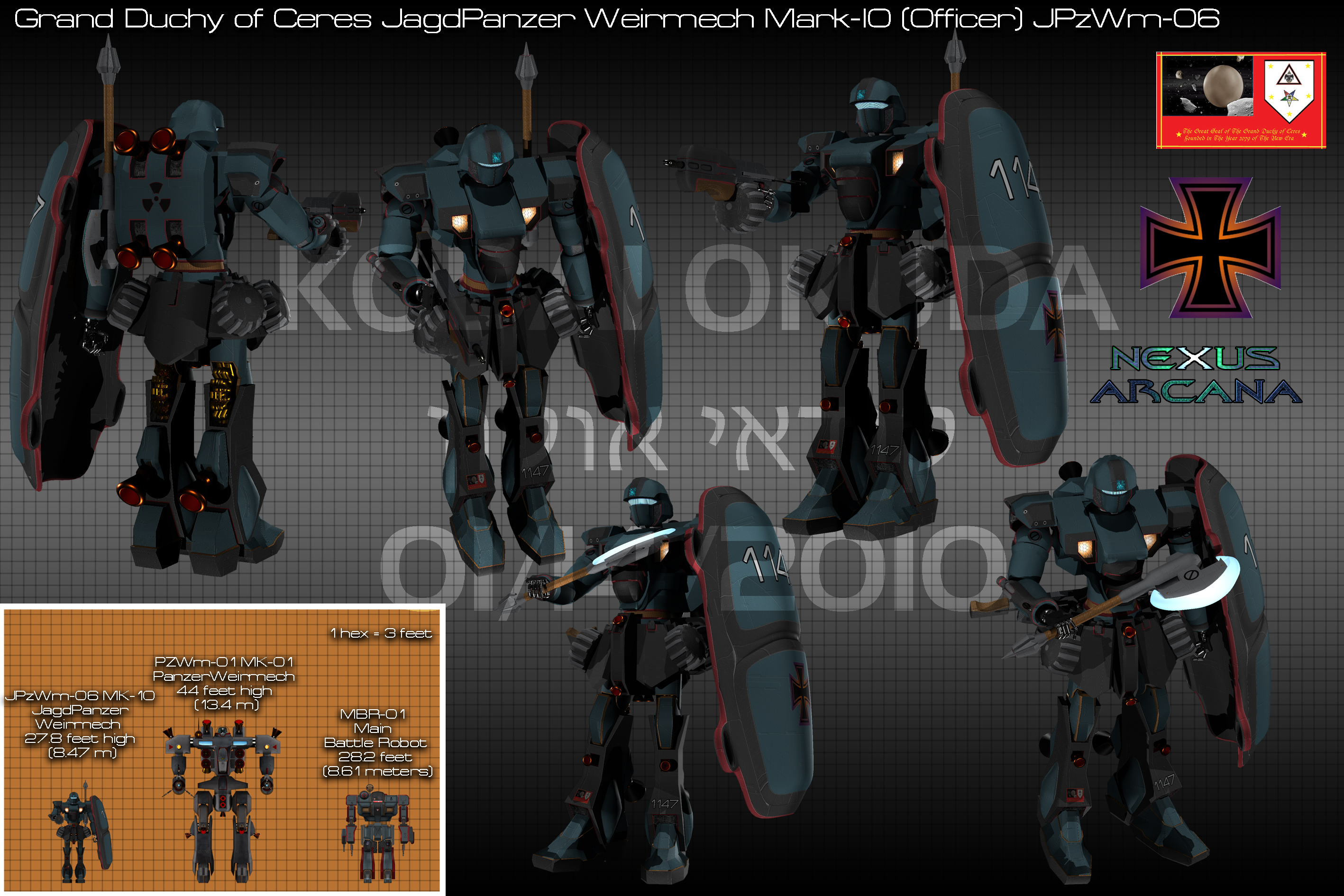
(MARK-1O OFFICER CONFIGURATION)
The last standardized configuration used by the Grand Duchy was the Officer type. This unit is identical to that of the MARK-IN, only in place of the plasma sword it uses a Watzler WBC-04 four-megawatt beam ax as its proximal weapon. There is usually only one of these units per platoon. A typical platoon of JPzWM-06s would have one MK-IO, three MK-INs, four MK-IBs, and twelve MK-IGs for a total of twenty JagdPanzers.
During the Ceres Conflict the JagdPanzer distinguished itself on numerous occations as being a viable alternative to larger, often times more heavily armored, battlerobots. It also proved that a general purpose basic robot unit could replace an entire line of different models of battlerobots just by using outside weapons in place of integrally mounted ones. The numbers of JagdPanzers built by the Grand Duchy during the early 2180s is unknown. What is known is that after the fall of the Grand Duchy, the USSR constructed tens of thousands of these units, most of which served in the 2nd Interplanetary War. However, by the time of the 2230s, this machine was showing its age and was replaced by newer, more advanced versions of it.